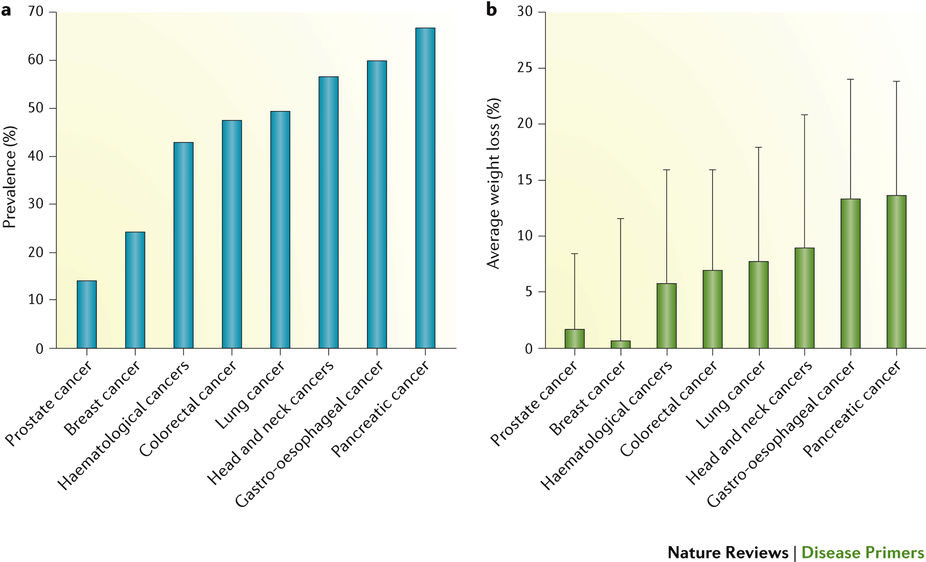がん悪液質
Cancer-associated cachexia
2018年1月18日 Nature Reviews Disease Primers Article number: 17105 (2018) doi: 10.1038/nrdp.2017.105

がん悪液質は、骨格筋と脂肪組織の特異的減少を伴う体重減少を特徴とする障害である。がん悪液質は、食欲不振に加えて、エネルギー消費量の亢進、過剰な異化、炎症などの代謝異常が複合して発症する。がん悪液質は、膵がん、食道がん、胃がん、肺がん、肝がんおよび膀胱がんで頻繁に見られる。これらのがんは世界のあらゆるがん死亡原因の半数を占める。がん悪液質の発症には、その腫瘍微小環境内に存在するがん細胞だけでなく、炎症細胞や免疫細胞などから分泌されるさまざまなメディエーターが関与している。さらに、これらメディエーターの作用と、内分泌系、代謝系、および中枢神経系の異常が複合することで、骨格筋をはじめ、心臓筋や脂肪組織での異化障害が引き起こされる。このような組織中では、タンパク質分解、炎症反応、自食作用、脂肪分解などが活性化されている。がん悪液質によって、機能障害をはじめ、代謝異常や免疫異常などの多くの疾患が発症するだけでなく、がん治療の副作用と合併症が悪化する。患者は、がん悪液質によって、QOLが低下するだけでなく、肉体的、精神的、社会的健康の悪化や医療負担の増加に苛まれる。現在のところ、がん悪液質を完全に改善する効果的な医療介入はなく、承認された薬物療法もない。がん悪液質の治療では、適切な栄養サポートが重要になるが、現在、過剰な異化作用、細胞障害および炎症を標的とした薬物療法の評価が進められている。
PrimeView
がん悪液質は、進行性の機能障害、がん関連死亡および治療関連合併症をもたらす。このPrimeViewでは、この重篤な症候群の治療に関する最近の研究成果について解説する。
本Primerの図解サマリー
Cancer-associated cachexia is a disorder characterized by loss of body weight with specific losses of skeletal muscle and adipose tissue. Cachexia is driven by a variable combination of reduced food intake and metabolic changes, including elevated energy expenditure, excess catabolism and inflammation. Cachexia is highly associated with cancers of the pancreas, oesophagus, stomach, lung, liver and bowel; this group of malignancies is responsible for half of all cancer deaths worldwide. Cachexia involves diverse mediators derived from the cancer cells and cells within the tumour microenvironment, including inflammatory and immune cells. In addition, endocrine, metabolic and central nervous system perturbations combine with these mediators to elicit catabolic changes in skeletal and cardiac muscle and adipose tissue. At the tissue level, mechanisms include activation of inflammation, proteolysis, autophagy and lipolysis. Cachexia associates with a multitude of morbidities encompassing functional, metabolic and immune disorders as well as aggravated toxicity and complications of cancer therapy. Patients experience impaired quality of life, reduced physical, emotional and social well-being and increased use of healthcare resources. To date, no effective medical intervention completely reverses cachexia and there are no approved drug therapies. Adequate nutritional support remains a mainstay of cachexia therapy, whereas drugs that target overactivation of catabolic processes, cell injury and inflammation are currently under investigation.

